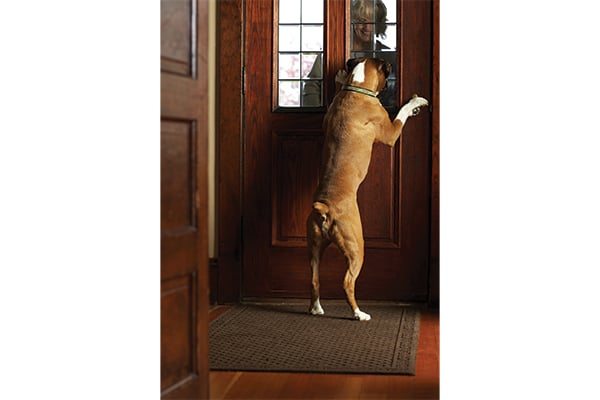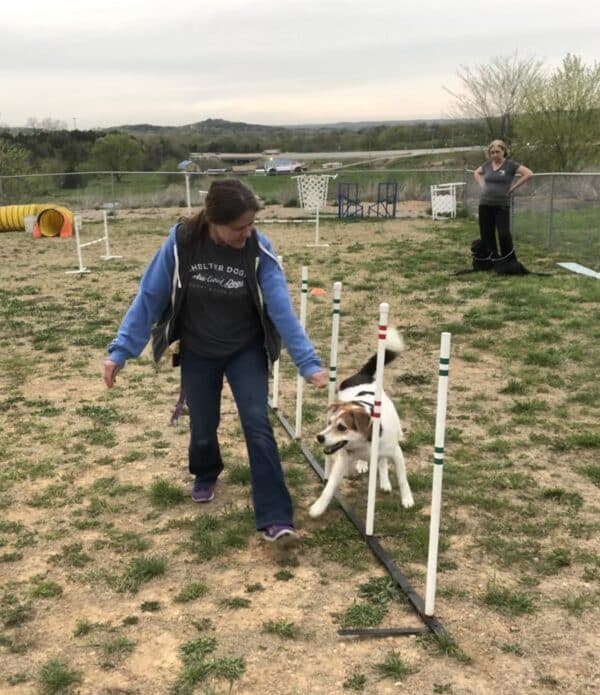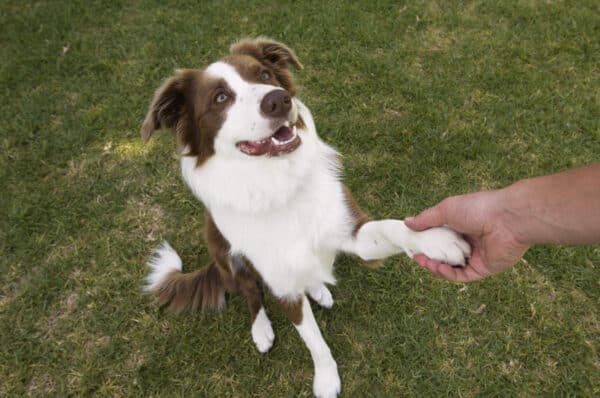One of the most common reasons dog owners hire a dog trainer is to help calm down the frenzied behavior at the homeowner’s front door. A door is a literal threshold, and many dogs seemingly lose their minds at this threshold.
The time for training your dog to greet new people calmly is not just after the doorbell rings and there is a stranger at your door. Most dogs overreact to the ding-dong sound, as they know someone new and exciting or scary and dangerous is standing on the other side. The dog pairs the ding-dong sound with activity at the door. Whether your dog is opting to guard you when you don’t really need it or your dog is nearly knocking down your guest with enthusiasm, either approach is less than ideal and can be dangerous.
Ding! Dong! Preferred behaviors
From a dog’s perspective, someone at the door can be really exciting or really scary. There is a new person to sniff and to get attention from or there is a potential threat to the homestead. If you were a dog and you spent most of your day indoors with little mental stimulation, boy-oh-boy is it exciting to hear that doorbell!

The very best time to train more preferred door behaviors is when the dog or puppy first comes into your home. If we teach a dog no other desired behaviors at the door, the dog chooses the ones that make the most sense to him.
I encourage clients to get a handheld remote doorbell device (on Amazon or at a hardware store) and use it to train the behavior you want first with no human on the other side of the door. The idea is to pair that ding-dong sound with a certain behavior from your dog. Many of my clients like training their dog to run to his bed when he hears that particular sound. Others have their dog sit and stay, and they build up those behaviors before working at the door. In other words, the ding-dong (or knock) can become the cue to sit, lie down, go to his bed or any behavior that is incompatible with rushing the door and mobbing your guests.
Training tips
Now that you know you can and should train alternative door behaviors, what happens next — when the person moves across that important threshold from the door into your home? How your dog reacts to meeting new people out on a walk can give you some clues.
Here are top training words of advice:
- Acknowledge that your dog needs training to understand the manner in which humans like to be greeted. If dogs aren’t trained, they make their own doggie decisions that likely include a jump up to lick or sniff a human face. Some dogs might well throw in a strong nose sniff up your visitor’s bum! Don’t blame the dog, as he is just being what he is: a dog saying hello.
- Train an incompatible behavior. A dog cannot sit and jump up at the same time. I train all of my dogs to offer me a ton of sits on their own that I highly reinforce. The dog learns better when in a non-chaotic environment (at first) that offering a sit gets them a jackpot from the human. I want a dog to have a default behavior so that when he is unsure what to do, he sits. Rewarded behavior continues. Focus on teaching your dog what you do want him to do versus yelling “no!” at him. NO! is not a behavior.
- It’s time to train with distractions — after your dog has learned to offer you your favorite default behavior — such as greeting a new human inside or outside of your home. By now you should have practiced reinforcing an offered sit as well as rewarding a sit after you give that all-important cue. Have someone the dog knows well come through the door or into a room, and get ready to rapid-fire reinforce the dog sitting. Have the “newcomer” ignore the dog at first. Gradually have the person greet the dog with a calm, soft pet to the chest or back. If the
person is overly excited, that can and does transfer to an overly excited dog. Calm in both species sets the stage for good training. - Take the show on the road. Practice greeting people known to the dog first and then work up to friendly strangers. Have the well-known person assist you in this important way: He or she walks up to the dog but just out of jumping range and waits for a few seconds. If the dog has rehearsed a default sit hundreds of times in the past, the dog easily offers a sit. Your greeter then calmly offers a delicious treat or a gentle petting session. If the dog jumps up in his excitement, have the greeter step away from the dog and wait. When the dog sits again, the greeter comes back in for a pet or a treat.
- Know your dog’s preferences. Dogs are individuals, just as we are. Some people love to hug others and hug everyone hello and goodbye. Other people only want to hug people they know well. Your dog is not under any obligation to get a hug from every human you come across. Respect your dog’s personality and train the behaviors you want, and you are on your way to a happy, well-trained dog who has learned to feel safe and secure meeting new people or feeling secure that it is OK to walk on by and not be petted if that makes him uncomfortable.
Dogs need our guidance. They do not arrive on our doorstep understanding the ways of their human families. Keep in mind the idea of training an incompatible behavior and/or heavily reinforce the behaviors your dog offers that you do like, as that makes both species happy and on the same team.
Thumbnail: Photography by: ©Thomas Northcut | Getty Images
About the author:
Annie Phenix, CPDT-KA, is a professional dog trainer based in Utah. She is a force-free trainer specializing in working with troubled dogs. She is the author of The Midnight Dog Walkers: Positive Training and Practical Advice for Living With a Reactive or Aggressive Dog. For more information, visit phenixdogs.com.





